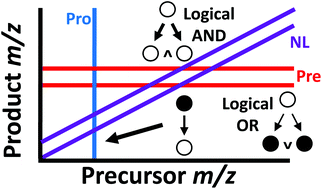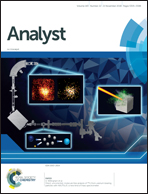Logical MS/MS scans: a new set of operations for tandem mass spectrometry†
Abstract
A new set of operations for tandem mass spectrometry in a linear ion trap is described. Logical MS/MS operations categorize compounds in mixtures based on characteristic structural features as revealed by MS/MS behavior recorded in multiple fragmentation pathways. This approach is a conceptual extension of tandem mass spectrometry in which interrogation of the full data domain is performed by simultaneous implementation of precursor and neutral loss scans. This process can be thought of as moving through the 2D MS/MS data domain along multiple scan lines simultaneously, which allows experiments that explore the 2D data domain of MS/MS to be couched in terms of logical operations, AND, NAND (not and), OR (inclusive or), XOR (exclusive or), NOT, etc. Examples of particular logical conditions include all precursor ions that fragment to both of two selected product ions (logical AND), or all precursor ions that do not produce a specified fragment ion (logical NOT). These and other operational modes (TRUE/FALSE, XOR, OR, etc.) complement and extend the existing set of conventional MS/MS scans, namely product scans, precursor scans, and neutral loss scans. We describe the implementation of logical MS/MS scans on a commercial linear ion trap mass spectrometer using simple mixtures of amphetamines and fentanyl analogues and argue their utility for complex mixture analysis.

- This article is part of the themed collection: Analyst Recent HOT articles


 Please wait while we load your content...
Please wait while we load your content...